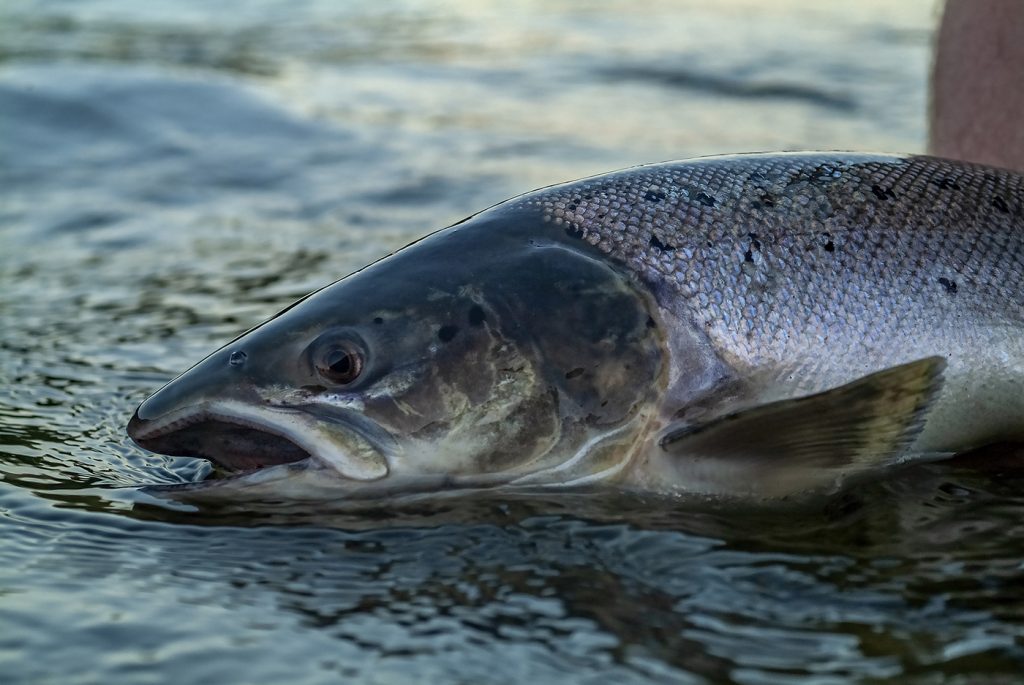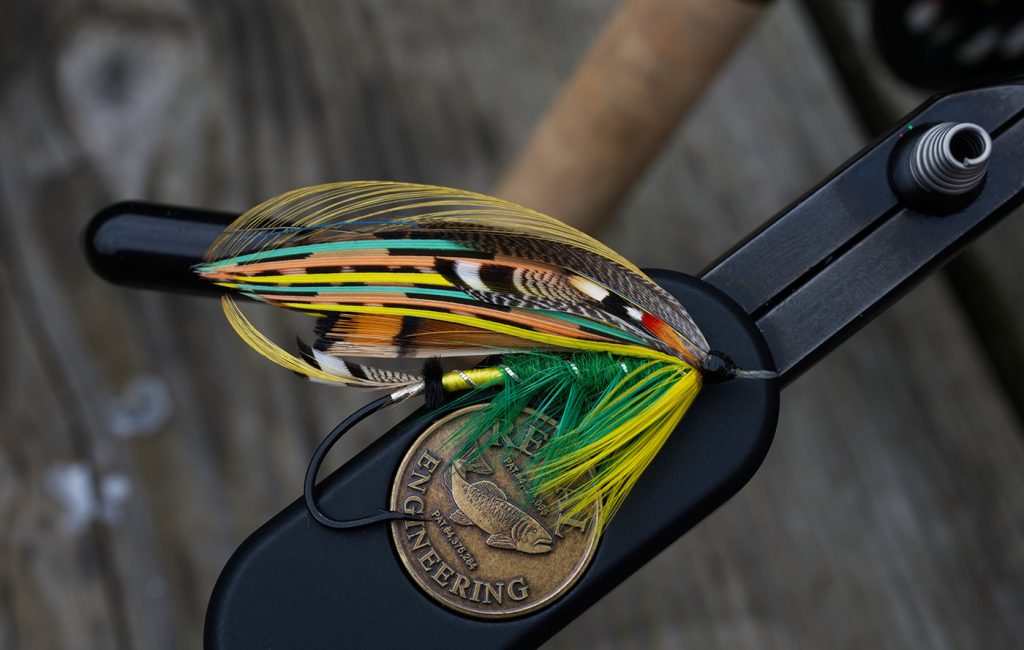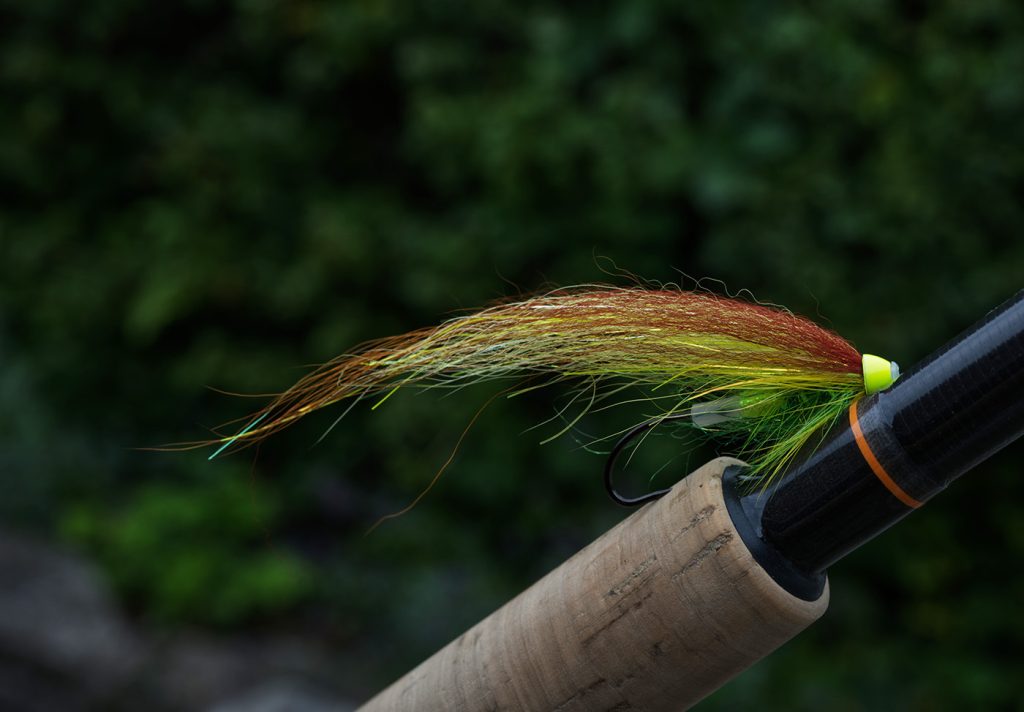
A century ago it wasn’t uncommon, in fact it was the norm, to fish for salmon with huge hooks. Size 2/0 was a small one and when hauling from boats, size 6/0 up to 8/0 were used. Although the rods were long and made of green heart and the lines heavy, I doubt they could cast an 8/0 salmon iron from the bank. On the other hand, a certain Alexander Grant made a witnessed 65 yard spey cast with a double handed green heart rod. So who knows?

Flies like this, the Green Highlander, taking hours to tie on huge hooks, requiring exotic and rare materials, were cast across the stream in search of the fish of a thousand casts. By comparison, this is a small one, a size 1/0, I think. Tied by Håkan Karsnäser.
There is no doubt that big flies, even huge flies are effective when fishing for salmon, especially for the early, huge silvery June fish and the earlier springers in Scotland. Luckily for us and the salmon, if they are to be released, the modern tube flies present us with a much better solution for fishing and casting big flies. With the modern multi density sinking lines, we not even dependant on the heavy hooks to fish deep. A light weight tube fly on a sinking line is much more mobile in the currents. The fly fisher chooses whether to fish a single-, double- or treble hook and its size.

A modern Scandi-style Green Highlander. The colours are a bit sharper, it has abundant flash and yet, being longer than a 6/0 hooks, it’s light weight. And it’s infinitely more mobile, easier and faster to tie and requires no exotic impossible-to-get materials.
Tube flies are generally excellent fishing flies and more common along the Scandinavian rivers than hook flies. But tube flies don’t have to be big. They can be just as effective and relevant for smaller flies – even minute flies. A micro tube, nearly weightless in the water, still has the advantage that the hook can be replaced if nicked on a stone. A lot of salmon fishers are reluctant to fish minute flies, but it’s often the best choice in the backend of the season. If worried about the hook hold, maybe one of our HR 450 Tube Trebles can offer a bit more confidence? We make them as small as size 14.

I almost can’t write about salmon flies without including the IceMan, my favourite, and here in a simple, micro version. A 4-5 mmm tube, three very small bunches of hair, a little flash and an HR 450 #14. The fly is 3cm long. It’s ready to go, but on fairly heavy tackle. I just love fishing a long rod and long belly spey lines, when the water is low. Long casts are rarely necessary, so a long belly spey line can be cast, fished and re-cast without retrieving any line. A spey line can also make very delicate and precise presentations, which makes sense when fishing micro flies. On the smallest of tube flies, I mostly let the hook swing freely.
Who can travel to Norway, Scotland, Labrador or else where for salmon without bringing a Green Highlander in some incarnation? I can’t – or at least I won’t. A big version like the one above is generally a very effective fly in high water, when it’s not too murky. The lower the water is, the smaller the fly I choose, like everyone else (at least most of the time). If the water really drops and becomes crystal clear, which often happens in the late summer, I’m happy to fish a Green Highlander again. But of course a small one.

A minute Green Highlander-style micro tube fly next to a bigger one (the same as above). As the micro IceMan, a 3-4mm tube, a little dubbing, yellow, chartreuse and brown hair, and a little flash. Far from the original, but still in the same colour scheme. Sometimes that’s all it takes.
If you haven’t already, try tying and fishing some really small tube flies. Have a look at this small Red Butt bead tied by Stefan Enevoldsen from Mörrum in Sweden – a real classic pattern that in small sizes have fooled a big amount of very big both salmon and seatrout in the famour river.
And offcourse the above mentioned Green Highlander as a almost classic style – but with a soft hairwing instead of the traditional made of strips of feathers tied by danish Casper Hansen.
